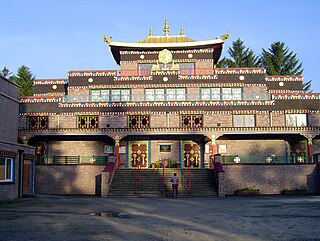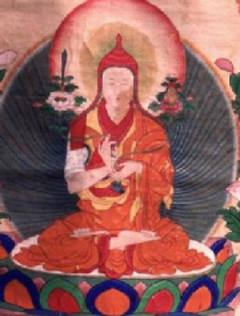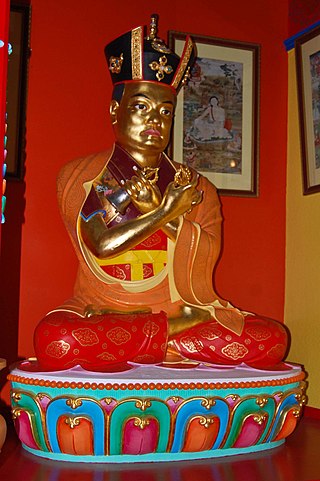
Chögyam Trungpa was a Tibetan Buddhist meditation master and holder of both the Kagyu and Nyingma lineages of Tibetan Buddhism.
A tulku is a distinctive and significant aspect of Tibetan Buddhism, embodying the concept of enlightened beings taking corporeal forms to continue the lineage of specific teachings. The term "tulku" has its origins in the Tibetan word "sprul sku", which originally referred to an emperor or ruler taking human form on Earth, signifying a divine incarnation. Over time, this term evolved within Tibetan Buddhism to denote the corporeal existence of highly accomplished Buddhist masters whose purpose is to ensure the preservation and transmission of a particular lineage.

Kagyu Samye Ling Monastery and Tibetan Centre is a Tibetan Buddhist complex associated with the Karma Kagyu school located at Eskdalemuir, Scotland.

Chöje Akong Tulku Rinpoche was a tulku in the Kagyu school of Tibetan Buddhism and co-founder of the Samye Ling Monastery in Scotland, Tara Rokpa Therapy & ROKPA International Charity.

Lama Yeshe Losal Rinpoche is a lama in the Kagyu school of Tibetan Buddhism and abbot of the Kagyu Samye Ling Monastery and Tibetan Centre, Scotland, the first and largest of its kind in the West.

The sixteenth Gyalwa Karmapa, Rangjung Rigpe Dorje was the spiritual leader of the Karma Kagyu lineage of Tibetan Buddhism. Followers believed him to be part of the oldest line of reincarnate lamas in Vajrayana Buddhism, known as the Karmapas, whose coming was predicted by the Buddha in the Samadhiraja Sutra. The 16th Karmapa was considered to be a "living Buddha" and was deeply involved in the transmission of the Vajrayana Buddhism to Europe and North America following the Chinese invasion of Tibet. He had many monikers, including "King of the Yogis", and is the subject of numerous books and films.

Jamgön Kongtrül Lodrö Thayé, also known as Jamgön Kongtrül the Great, was a Tibetan Buddhist scholar, poet, artist, physician, tertön and polymath. He is credited as one of the founders of the Rimé movement (non-sectarian), compiling what is known as the "Five Great Treasuries". He achieved great renown as a scholar and writer, especially among the Nyingma and Kagyu lineages and composed over 90 volumes of Buddhist writing, including his magnum opus, The Treasury of Knowledge.

Karma Kagyu, or Kamtsang Kagyu, is a widely practiced and probably the second-largest lineage within the Kagyu school, one of the four major schools of Tibetan Buddhism. The lineage has long-standing monasteries in Tibet, China, Russia, Mongolia, India, Nepal and Bhutan, with current centres in over 60 countries. The spiritual head of the Karma Kagyu is the Gyalwa Karmapa; the 2nd among the 10 Karmapas had been the principal spiritual advisors to successive emperors of China. The Karma Kagyu are sometimes called the "Black Hat" lamas, in reference to the Black Crown worn by the Karmapa.

Jamyang Khyentse Wangpo, also known by his tertön title, Pema Ösel Dongak Lingpa, was a teacher, scholar and tertön of 19th-century Tibet. He was a leading figure in the Rimé movement.
Surmang refers to a vast alpine nomadic and farming region, historically a duchy under the King of Nangchen, with vast land holdings spreading over what is today the Tibet Autonomous Region and Qinghai Province. In Tibetan the King of Nangchen's realm was called the "nyishu dza nga" or the 21 (provinces). Since 1959 it is mainly within the Yushu Tibetan Autonomous Prefecture of Qinghai province in China. Yushu Prefecture is 97% ethnic Tibetan. The Surmang region is one of the poorest regions in China ranking it among the world's highest infant and maternal mortality, almost 100% illiteracy, and personal income of less than US 14¢/day. It is part of the catchment in China of the 30 million ultra-poor.

Tulku Urgyen Rinpoche was a Buddhist master of the Kagyü and Nyingma lineages who lived at Nagi Gompa hermitage in Nepal. Urgyen Rinpoche was considered one of the greatest Dzogchen masters of his time.

Kyabje Dudjom Jigdral Yeshe Dorje was known as Terchen Drodül Lingpa and as Dudjom Rinpoche. He is considered by many Tibetan Buddhists to be from a line of important Tulku lineage, and a renowned Tertön. Per lineage, he was a direct incarnation of both Padmasambhava and Dudjom Lingpa (1835–1904). He was a Nyingma householder, yogi, and a Vajrayana and Dzogchen master. According to his disciple Khenpo Tsewang Dongyal, he was revered as "His Holiness" and as a "Master of Masters".

Sherab Palden Beru was an exiled Tibetan thangka artist who played a key role in preserving the art-form through the training of western students over a period of more than four decades.
Namgyal Rinpoche, Karma Tenzin Dorje (1931–2003), born Leslie George Dawson in Toronto, Canada, was a Tibetan Buddhist lama in the Karma Kagyu tradition.
Benchen Monastery is the name of two Buddhist temples. The original Benchen Monastery in Tibet was destroyed by the Chinese Army in 1959. It later began to be reconstructed by the surviving sangha in the 1980s. The second Benchen monastery in Kathmandu, Nepal was constructed under the direction of two exiled Tulkus from the original monastery.

Pema Dönyö Nyinje is the 12th Tai Situpa, a tulku in Tibetan Buddhism, and one of the leading figures of the Karma Kagyu school. He is the head of Palpung Monastery.

Khenchen Palden Sherab Rinpoche, also known as "Khen Rinpoche," was a teacher, a scholar, a lama, and a Dzogchen master in the Nyingma school of Tibetan Buddhism. He was considered by Penor Rinpoche to be one of the most learned living Nyingma scholars. Palden Sherab founded the Orgyen Samye Chokhor Ling Nunnery, the first nunnery in Deer Park (Sarnath).

Buddhism in Scotland is a relatively recent phenomenon. In Scotland Buddhists represent 0.24% of the population or around 13,000 people.
Chime Tulku Rinpoche is a Buddhist Tulku. Rinpoche was born in 1991 into the family of Jamyang Khechog, an official at Surmang Namgyal Tse monastery.


















